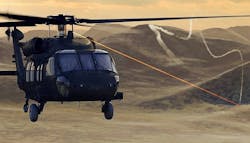Leidos to enhance semiconductor lasers for electro-optics applications in infrared countermeasures
Officials of the Air Force Research Laboratory's directed energy directorate at Kirtland Air Force Base, N.M., announced a $13.9 million contract to Leidos on Monday for the COmpact Semiconductor Mid- and long-wave Opto-electronic (COSMO)research project.
The COSMO program seeks to advance semiconductor lasers for current and future infrared countermeasures systems to deny enemies the use of infrared sensors like missile guidance, night-vision devices, and nighttime targeting systems.
The COSMO project is part of the Air Force's Semiconductor Laser (SCL) program to advance the state-of-the-art in compact high-brightness semiconductor laser devices emitting at the mid- and long-wave infrared wavelengths. Mid-wave infrared emits in the 3-to-5-micron bands, and long-wave infrared emits in the 8-to-12-micron bands.
Leidos will concentrate on developing and packaging mid- and long-wave infrared semiconductor laser devices, including development and testing of individual and multi-device format quantum cascade laser (QCL) and diode laser (DL) component technology.
Leidos engineers will use their expertise in exercising beam combining strategy to achieve higher output power, and switching high brightness QCL and DL modules for test, evaluation, prototyping, and incorporation into infrared countermeasures systems.
Leidos engineers will work primarily at Kirtland Air Force Base, which has specialized equipment like molecular beam epitaxial system; focused ion beam and scanning electron microscope system; X-ray diffractometer; Fourier transform infrared spectroscopy system; reactive ion etching system; inductively coupled plasma reactive ion etching system; mask aligner; plasma-enhanced chemical vapor deposition system; and evaporative metal deposition system.
The company's research work will involve advanced concept analysis, QCL material design and development; laser prototype and final packaging; and laser system design and integration.
Leidos should be finished with this contract by April 2023. For more information contact Leidos online at www.leidos.com, or the Air Force Research Lab's directed energy directorate at www.kirtland.af.mil/Units/AFRL-Directed-Energy-Directorate.
Ready to make a purchase? Search the Military & Aerospace Electronics Buyer's Guide for companies, new products, press releases, and videos

